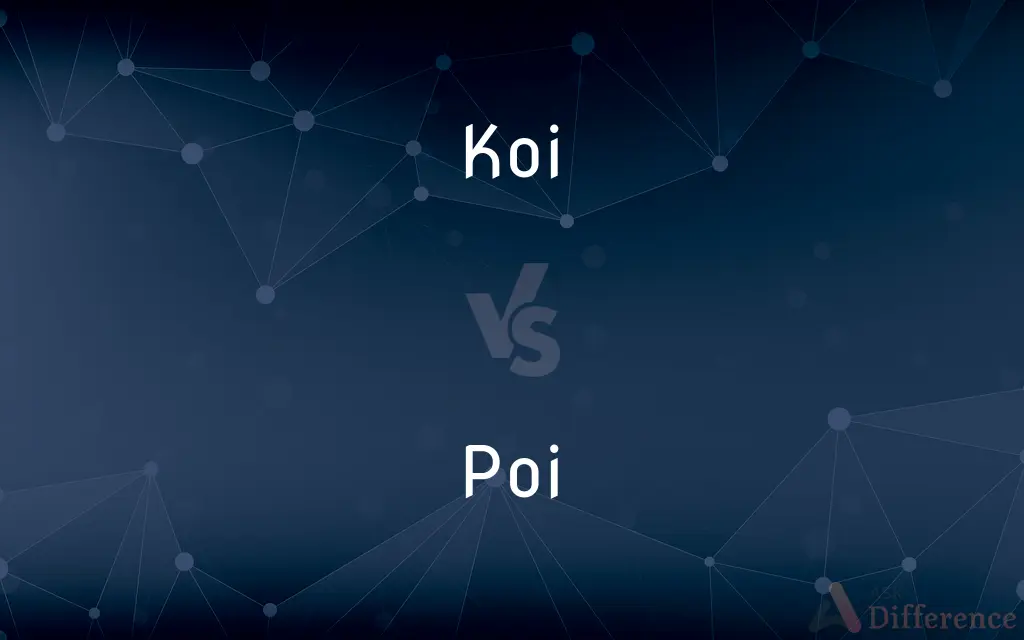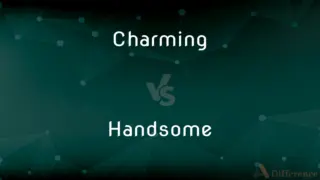Koi vs. Poi — What's the Difference?
By Fiza Rafique & Urooj Arif — Updated on March 17, 2024
Koi are ornamental varieties of domesticated carp, admired for their vibrant colors and patterns in water gardens. Poi is a traditional Polynesian food made from fermented taro root, noted for its paste-like consistency and role in Hawaiian cuisine.

Difference Between Koi and Poi
Table of Contents
ADVERTISEMENT
Key Differences
Koi are decorative fish, selectively bred from common carp, originating from East Asia and particularly popular in Japan. They are celebrated for their bright colors, intricate patterns, and graceful swimming, making them a centerpiece in outdoor ponds and water gardens. Poi, on the other hand, is a staple food in Hawaiian cuisine, made by mashing the cooked, fermented corm of the taro plant. It has a unique, smooth texture that can range from liquid to dough-like consistency, depending on preparation.
Koi varieties are distinguished by coloration, patterning, and scalation, and they are often associated with symbolism in Japanese culture, representing love, friendship, and perseverance. Poi is traditionally eaten with the fingers and has a slightly sour taste due to fermentation. It is rich in vitamins and minerals and is considered a highly nutritious part of the Hawaiian diet. Poi also holds cultural significance in Hawaii, embodying a deep connection to the land and its traditions.
While koi are living creatures appreciated for their aesthetic appeal in aquatic settings, poi is a food product valued for its nutritional benefits and cultural importance. The appreciation of koi is often related to hobbies, landscaping, and cultural symbolism, whereas poi is integral to traditional Hawaiian meals and ceremonies.
Koi cultivation involves breeding for specific traits, pond maintenance, and care to ensure the health and beauty of the fish. In contrast, poi production involves agricultural practices for growing taro, followed by a culinary process of cooking, mashing, and fermenting the root to achieve the desired flavor and texture.
Despite their vastly different natures—one being an aquatic animal and the other a food item—both koi and poi hold significant cultural value in their respective contexts, symbolizing the connection between nature, culture, and artistry.
ADVERTISEMENT
Comparison Chart
Nature
Ornamental fish
Traditional food
Origin
East Asia, particularly Japan
Polynesia, notably Hawaii
Significance
Symbolizes love, friendship, perseverance
Represents connection to land and tradition
Usage
Decorative in ponds and water gardens
Consumed as part of Hawaiian cuisine
Characteristics
Vibrant colors, patterns, and scalation
Paste-like consistency, slightly sour taste
Cultural Context
Associated with landscaping and symbolism
Integral to traditional meals and ceremonies
Production/Care
Involves breeding, pond maintenance
Involves agriculture, cooking, fermenting taro
Compare with Definitions
Koi
Domesticated ornamental carp.
The vibrant koi in the pond are the highlight of the garden.
Poi
Polynesian food from taro root.
Poi is a staple at traditional Hawaiian luaus.
Koi
Bred for color and pattern.
The breeder showcased a rare patterned koi at the exhibition.
Poi
Fermented taro paste.
The poi served had a perfect balance of tangy and smooth texture.
Koi
Symbol in Japanese culture.
Koi are often seen as symbols of perseverance in Japanese art.
Poi
Eaten with fingers.
At the dinner, guests were encouraged to try eating poi the traditional way.
Koi
Aquatic pets.
Many enthusiasts keep koi for their serene beauty and calming effect.
Poi
Nutritious traditional meal.
Poi is not only traditional but also packed with essential nutrients.
Koi
Part of water garden aesthetics.
The landscaper designed the pond specifically for koi keeping.
Poi
Cultural significance in Hawaii.
Poi holds a special place in Hawaiian ceremonies, symbolizing connection to the land.
Koi
Koi (鯉, English: , Japanese: [koꜜi]) or more specifically nishikigoi (錦鯉, Japanese: [ɲiɕi̥kiꜜɡoi], literally "brocaded carp"), are colored varieties of the Amur carp (Cyprinus rubrofuscus) that are kept for decorative purposes in outdoor koi ponds or water gardens. Koi is an informal name for the colored variants of C. rubrofuscus kept for ornamental purposes.
Poi
A Hawaiian food made from the corm of the taro that is cooked, pounded to a paste, and fermented.
Koi
A variety of carp (Cyprinus carpio) developed in Japan and widely raised as an ornamental fish for its bright color patterns.
Poi
A traditional Maori performance art in which one swings in each hand a rope with a ball at the end, usually in specific, complex patterns.
Koi
Ornamental domesticated varieties of the common carp (Cyprinus carpio), of Japan and eastern Asia with red-gold or white coloring.
Poi
(Hawaii) The traditional staple food of Hawaii, made by baking and pounding the kalo (or taro) root, and reducing it to a thin paste, which is allowed to ferment.
Poi
A creamy Samoan dessert of ripe bananas mashed with coconut cream.
Poi
(New Zealand) A small ball made of leaves and fibres, attached to a string.
Poi
(New Zealand) A traditional dance performed by Maori women involving the rhythmic swinging of such a ball.
Poi
A national food of the Hawaiians, made by baking and pounding the kalo (or taro) root, and reducing it to a thin paste, which is allowed to ferment.
Poi
Hawaiian dish of taro root pounded to a paste and often allowed to ferment
Common Curiosities
What are the main differences between koi and poi?
Koi are ornamental fish valued for their beauty, while poi is a traditional Polynesian food made from taro root.
Can koi live in any type of water body?
Koi can live in various water bodies but thrive best in well-maintained ponds with proper filtration and aeration.
What do the colors and patterns of koi represent?
Koi colors and patterns can represent various attributes, including luck, prosperity, and personal growth, depending on cultural beliefs.
How long can koi fish live?
With proper care, koi fish can live for several decades, with some reported to live over 100 years.
Is there a specific season for poi consumption?
Poi can be consumed year-round, but availability might be influenced by taro harvest seasons.
How is poi integrated into modern cuisine?
Poi is used in traditional and modern Hawaiian dishes, sometimes incorporated into contemporary recipes for a fusion of flavors.
Is poi consumed daily in Hawaiian cuisine?
Poi is a traditional food and may be consumed regularly by some, but not necessarily daily by all Hawaiians.
Can poi be made from other roots besides taro?
Poi is specifically made from taro, but similar dishes in other cultures might use different roots.
Are there health benefits associated with eating poi?
Yes, poi is rich in vitamins, minerals, and dietary fiber, making it a nutritious part of the diet.
How is poi traditionally prepared?
Poi is made by cooking, mashing, and fermenting the taro root until it reaches a paste-like consistency.
Is poi always fermented?
Poi is traditionally fermented to some degree, which gives it its characteristic sour taste, but the level of fermentation can vary.
What is the cultural significance of koi in Japan?
In Japan, koi are revered for their beauty and are often associated with qualities like perseverance and strength.
What does it mean when koi swim upstream in art?
Koi swimming upstream in art symbolize perseverance and overcoming obstacles, inspired by their natural behavior.
Do koi require special care?
Yes, koi require specific care in terms of diet, water quality, and pond environment to thrive.
What are the challenges in maintaining a koi pond?
Maintaining a koi pond involves regulating water quality, preventing disease, and providing a safe, stress-free environment for the fish.
Share Your Discovery

Previous Comparison
Charming vs. Handsome
Next Comparison
Incorporation vs. IntegrationAuthor Spotlight
Written by
Fiza RafiqueFiza Rafique is a skilled content writer at AskDifference.com, where she meticulously refines and enhances written pieces. Drawing from her vast editorial expertise, Fiza ensures clarity, accuracy, and precision in every article. Passionate about language, she continually seeks to elevate the quality of content for readers worldwide.
Co-written by
Urooj ArifUrooj is a skilled content writer at Ask Difference, known for her exceptional ability to simplify complex topics into engaging and informative content. With a passion for research and a flair for clear, concise writing, she consistently delivers articles that resonate with our diverse audience.














































